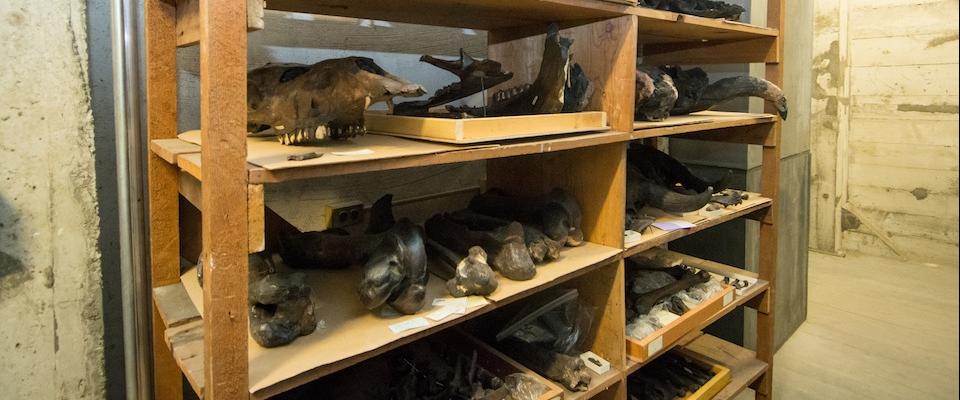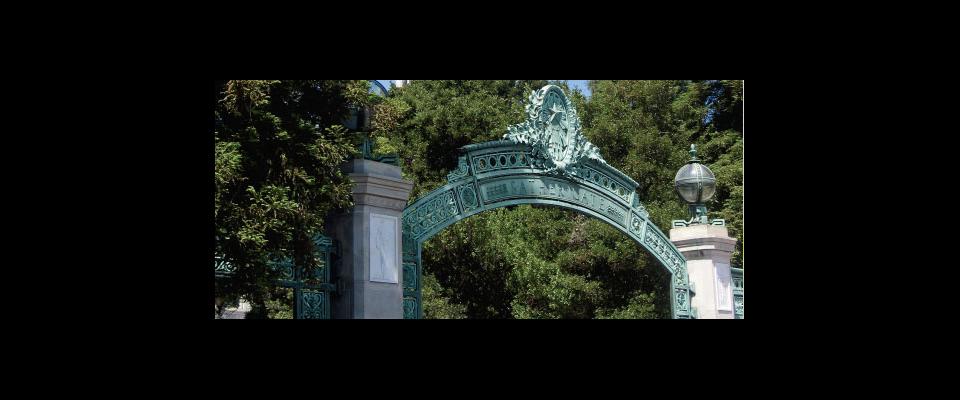Contrary to popular belief, “Big Ben” isn’t the iconic clock on the tower atop Britain’s Houses of Parliament; it’s the mammoth, 13.8-ton bell behind the clock, tolling the hours in a low E-natural.
Big Ben’s counterpart at UC Berkeley is the “Great Bear Bell” in the Jane K. Sather Tower—aka the Campanile—which is home to the University carillon and is celebrating its 100th birthday this year. Comparatively smaller but still a hefty 4.2 tons, the Great Bear Bell features bas-relief carvings of bears and the constellation Ursa Major. Most significantly, it tolls the hours in low G.
A carillon, for the uninitiated, consists of more than 23 bells. Any less is a mere chime, which is, by the way, what the Campanile originally housed after receiving its first 12 bells, inscribed “Gift of Jane K. Sather 1915.”
For decades the Campanile chime tolled the history happening around it: Only after a lengthy campaign of persuasion did the wary chimemaster agree to allow swing music by the 1940s, and after World War II’s VE Day, the bells rang for two solid hours in celebration.
But with only a dozen bells, the Campanile had a limited musical range. It simply couldn’t play many common tunes—including “The Star-Spangled Banner.”
So in 1978, the Class of 1928 decided to buy “a few bells” for the tower to celebrate the class’s 50th reunion. Those “few bells” totaled a whopping 36, quadrupling the tower’s complement to 48 and giving the Campanile, for the first time, a full-fledged concert carillon. Five years later, the bell collection would grow to a total of 61, a grand carillon, thanks to a donation from Cal alum Jerry Chambers and his wife, Evelyn. One of the Chambers’ bells displays a bas-relief sculpture of a 19th-century clipper ship and is emblazoned with the name “Mary Ann Patton”—a woman who, curiously, had no connection to Cal.
“Jerry Chambers loved clipper ships,” explains Cal’s Jeff Davis, the only permanent, full-time university carillonist on the continent. “And he became especially enamored with the story of Mary Ann Patton, whose husband was a clipper ship captain. He became ill during a violent storm as they were sailing around the Horn, so she took over and saved the ship. Then she had to put down a mutiny. She jailed the mutineers and successfully sailed the ship into San Francisco Bay. And she was only 20 years old and pregnant at the time!”
Davis is the university’s third university carillonist since the position was created in 1983 as part of the Chambers’ endowment. The first, Ronald Barnes, served until 1995; his successor, Geert d’Hollander, served from 1997 to 1998; and Davis has served since 2000, with interim carillonists serving in between.
“I’ve always loved bell sounds ever since I was a little kid,” says Davis, who composed his first piece at the age of 4. “I came here in 1983, right after the carillon had just been enlarged. I sat in Faculty Glade every day listening to the recitals, and I was astonished that something that huge could be played that subtly.”
He approached Barnes and asked, “Do you ever teach carillon?”
Barnes replied, “Yes,” and walked away.
And that was that, or so Davis thought until a year later, when he was working as a factotum—his actual job title—in the music department. Barnes walked in one day and said, “Are you still interested?”
“Sure. How much does it cost?”
“Nothing. For the staff, it’s free. When do you want to start?”
“How about tomorrow?”
Davis had his first lesson the next day. Two months later, at the end of August 1984, he played the carillon for the first time. And never looked back. He finished his instruction and served as carillonist at the University of the South in Sewanee, Tennessee, returning to Cal as carillonist in 2000.
“If you have a carillon at a university, teaching is a no-brainer,” he says. “It’s a rare opportunity. So I put up a sign on the music department billboard reading, ‘Bells, anyone?’ That first semester I had five students, and I’ve been teaching ever since.”
The carillon is a physically demanding instrument. The heavier the bell, the heavier the clapper needed to ring it. You play it the same way you’d play a giant piano keyboard, except the “keys” are actually two-foot levers that move the clappers, which in turn strike the bells. To extract tones, you push downward on the keys with the side of your fists, and that can be rough on your arms—Davis often wears Ace bandages to reduce the strain in practice.
“Those clappers can weigh hundreds of pounds, so you can really wreck your wrists,” he says.
The heaviest bells are played with foot pedals, since legs are stronger than arms. And Davis takes great care never to play too many bells at the same time. “Bells are really weird acoustically,” he explains. “Any given bell is sounding five distinct pitches at the same time. So if you play three bells with five pitches, you’re sounding 15 different pitches, and it sounds like a mess. So you have to be very careful. Composing and arranging for the carillon is very tricky, and Ron Barnes is the most important person in the history of the carillon for sorting that out.”
Since nobody has a private carillon to learn on, students audition for Davis’s course by playing whatever instrument they like. “I love vocalists,” Davis says. “Vocalists and wind players are my favorite because they know how to breathe. Music is really all singing, and you can wear out your audience if you don’t let them breathe.
“I found this out while I was playing oboe. I was getting good at ‘circular breathing,’ when you breathe through your nose and use your cheeks as a bellows. I was playing a Wagner arrangement of a Gluck overture that has an endless oboe solo, so I decided to use circular breathing to see if I could play the whole thing without breaking the sound. So I did. The string players were sitting right in front of me. I could see them getting more uncomfortable the longer I played without a break. They were squirming in their seats.”
For the students who aspire to play the carillon—many of them not music majors—the audition itself is a learning experience.
“The audition process is really interesting,” says Joey Cotruvo, a post-doc student in chemistry. “I sat down and played my piece, and he said, ‘Great! Now, critique yourself.’ That’s the real audition. So I said a lot of negative things about my playing, and he said, ‘You know, you can think of positive things, too.’ So I came up with a couple of positive things. And that set the pattern for all of our lessons. We’ll play whatever we’re working on at the time, then he’ll ask for our thoughts, then he’ll add his own observations, and then we’ll go back and play more things.”
The carillon lessons are about far more than technique, says Nathan Roth, a Ph.D. candidate in astrophysics. “Jeff is knowledgeable about many aspects of music history and theory, so sometimes the lesson might focus on the historical or theoretical context of the piece we’re working on. I see each lesson as a conversation, and you can steer it in whatever direction is most productive.”
Friday, Saturdays and Sundays are open practice nights. “On most other instruments you can practice in private,” says Roth. “But with the carillon, the whole campus gets to hear your mistakes.”
As a result, the vast majority of their practicing is done on three practice keyboards in the tower.
“We’re on the first floor, right below the fossils,” says Roth. “Instead of the keys being hooked up to the bells, they’re hooked up to a vibraphone. So you don’t get a sense of the weight of the keys, but the spacing is the same.”
Eventually, the students advance to the real thing. “The weight issue is something that takes a while to get used to,” says Roth. “The first time I was up on the carillon, my hands were in the right place, but I wasn’t sounding the note. It’s much harder than you expect it to be. You’re moving a lot of metal instead of just moving a mallet.”
But it’s not all work. The carillon students are allowed to play anything they want, up to a point—recent tunes performed on the carillon include themes from The Lord of the Rings and Game of Thrones, and the Campanile’s anniversary celebration has included a light-and-sound performance of “Natural Frequencies,” a feat of seismic synchrony, modulated in real time by data from the UC Berkeley seismometer inside the Hayward Fault.
“If you’re going to play something frivolous, like arranging a Beyonce song, you should probably ask Jeff if that’s OK before playing it,” says Cotruvo.
And they also go on field trips. “Last year we went down to Stanford to play the bells in Hoover Tower,” Cotruvo says. “We wanted to play ‘Big C’ and ‘Fight For California,’ but Jeff nixed that. He said it wouldn’t be courteous to our hosts.”
One of the highlights of the year is the not-quite-annual Harry Potter potluck party on or around Halloween, complete with pumpkin-flavored cookies, Hogsmead chocolates, pumpkin juice (actually, orange soda, but it’s the thought that counts), readings of selected passages from The Cannon, and Davis playing “Hedwig’s Theme” on the carillon.
“The lights are dimmed until the only thing you can see is the keyboard, and Jeff puts on this magnificent beard and sorcerer’s hat and wand, and he’s no longer my music teacher; he’s Dumbledore!” says Thomas Le, a pre-med major who will graduate this spring. “During the rest of the year he uses the wand during class to point out things in the score.”
Cotruvo, Roth and Le are all scientists, as are a disproportionate number of Davis’s other students; and there are several theories why this is so.
“I think it’s because the Campanile is near the physics and chem buildings, says Cotruvo, the chemistry major.
“I think it’s because we like big things in the sky,” says Roth, the astronomy major.
Davis has his own theory: “I think people in the sciences are used to paying very close attention to small details, and that’s required of a musician, too,” he says. “A lot of scientists I’ve known have been very musically talented, but it’s not a reasonable way to make a living. Yet they’ve never lost their love of music.”
On the other hand, he admits, “I don’t understand anything about science myself. I’m a musician. It’s all a mystery to me.”
Carillon concerts take place three times a day on weekdays: 7:50 to 8 a.m., noon to 12:10 p.m., and 6 to 6:10 p.m. On Sundays, they occur from 2 to 2:45 p.m. Otherwise, the bells are not played so as not to disrupt classes.
And each semester on the precipice of finals week—in keeping with the ominous mood in the air—the carillon tolls the gloomy strains of “They’re Hanging Danny Deever In the Morning.” After that, the bells fall utterly silent and are not played again until the last final concludes.
Says Davis: “It’s a tradition going back to 1928.”
After decades of exposure to the elements, the carillon is starting to show signs of wear and tear; and other improvements are needed, including moving the exquisite-sounding treble bells to the top of the tower so they won’t be drowned out by the huge bass bells below. Davis estimates the cost to be about $1 million.
Videos courtesy of UC Berkeley




















